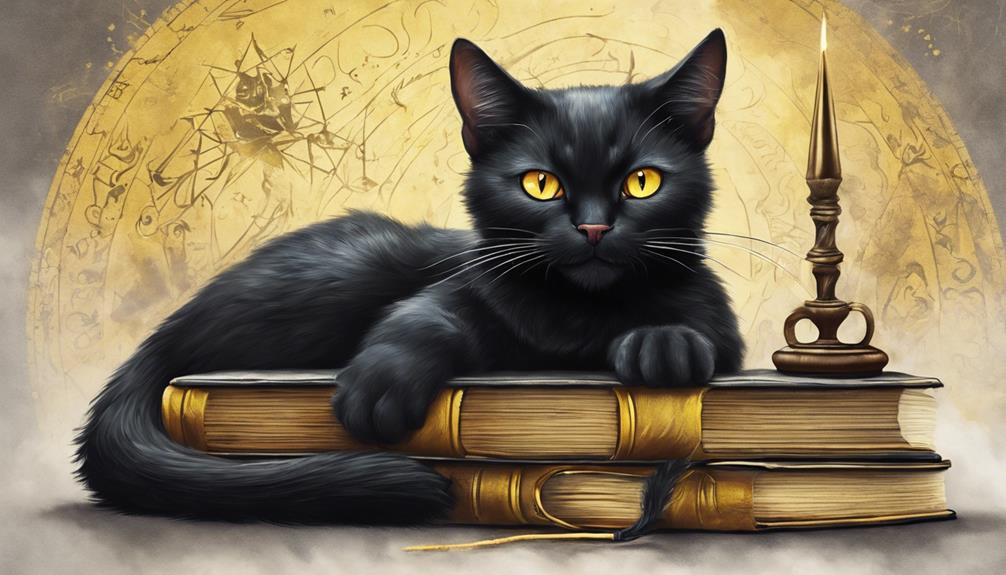Feeding cats biscuits can present risks due to high calories and harmful ingredients. Watch out for chocolate, xylitol, and excessive sugar in biscuits. Cats may struggle digesting carbs and lack essential nutrients. Avoid weight gain and diabetes by moderating biscuit intake. Allergic reactions can occur – look for symptoms like itching or vomiting. Opt for cat-specific biscuits or healthier snack alternatives. Consult a vet for advice on safe feline treats. Moderation and ingredient checks can help maintain cat wellness and prevent health issues. Guarantee feline safety with informed treat choices. Additional insights on caring for your feline companion await you.
Key Takeaways
- Cats can have plain, unsalted biscuits in moderation.
- Excessive biscuit consumption can lead to weight gain and health issues.
- Opt for cat-specific biscuits to meet their nutritional requirements.
- Wet food is a healthier snack alternative for cats.
- Balancing treats is crucial for overall feline well-being.
Risks of Feeding Biscuits to Cats
Feeding biscuits to cats can pose various risks to their health and well-being due to the high content of empty calories, carbs, and potential harmful ingredients. While it may be tempting to share our favorite snacks with our feline friends, it's important to take into account their nutritional needs.
Cats can eat biscuits, but it's vital to be cautious. These treats can be harmful to cats if consumed in excess, leading to issues like weight gain, diabetes, and heart disease. When feeding your cat biscuits, keep in mind that moderation is key. Opt for cat-specific biscuits that are formulated to meet your feline friend's dietary requirements.
Wet cat food is generally a better option for maintaining your cat's health due to its balanced nutrients. By offering biscuits only occasionally and in small amounts, you can minimize the potential health risks associated with these treats. Remember, your cat's well-being is our top priority!
Biscuit Ingredients to Watch For
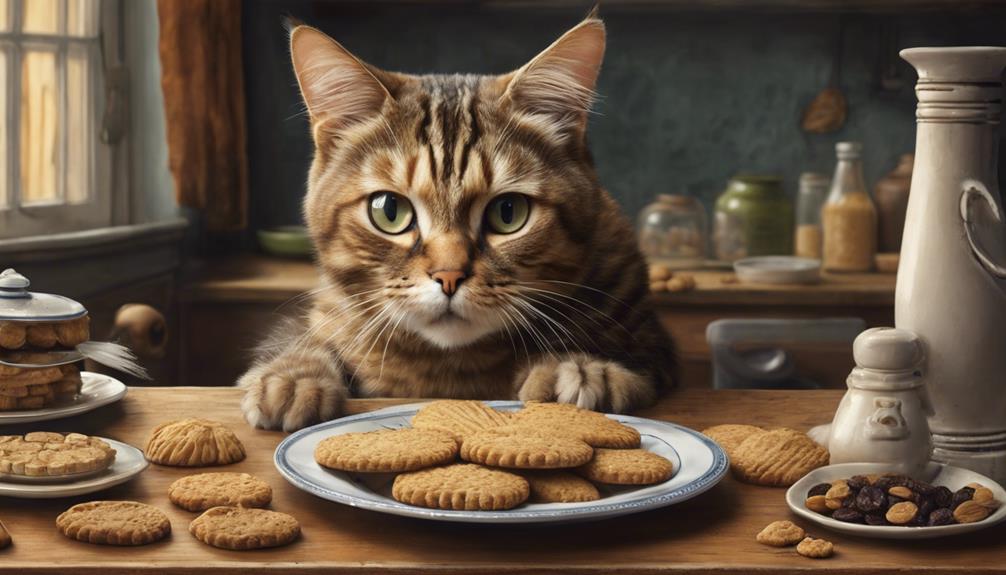
When contemplating the dangers of feeding biscuits to cats, it's important to be watchful about the ingredients present, especially those that can be harmful to feline health. Cats eat honey, but it's vital to avoid giving them biscuits with harmful ingredients like chocolate, raisins, xylitol, onions, garlic, or spices. These can be toxic to cats and lead to serious health issues.
Additionally, checking the nutritional amount of sugar and salt in human biscuits is essential as high levels can upset a cat's digestive system. To keep your feline friend healthy, steer clear of biscuits with excessive fat or additives that may cause obesity or other health problems. Opting for plain, unsalted biscuits made specifically for cats and carefully reading the ingredient list can help minimize the risk of allergic reactions or digestive issues.
Cats Digestive Response to Biscuits
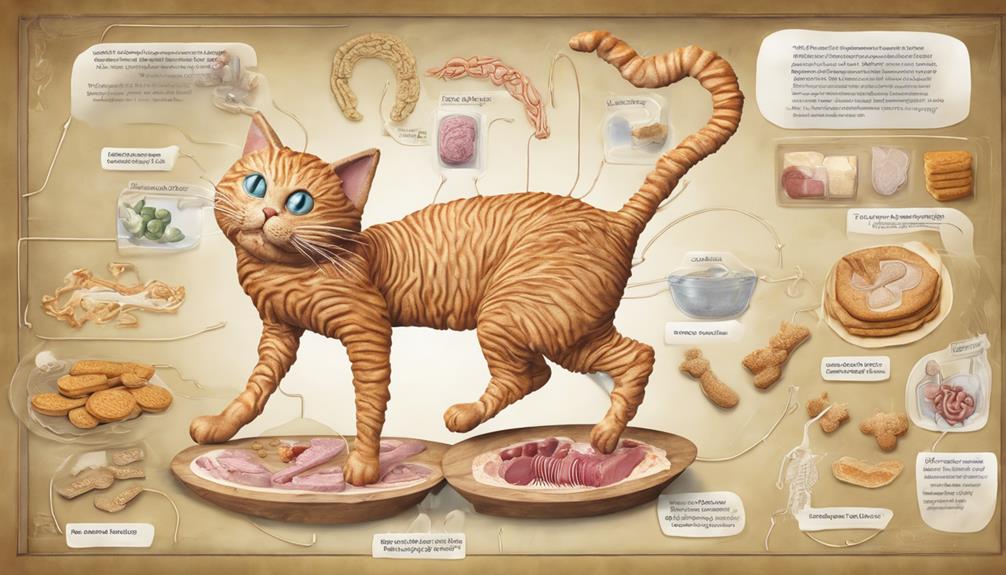
Sometimes cats struggle to digest the high carbohydrate content in biscuits. Cats' digestive systems aren't well-equipped to handle the complex carbohydrates found in biscuits. These treats lack essential nutrients like taurine, which are vital for feline health.
Additionally, the sugar and salt content in biscuits can be harmful to a cat's digestive system. Feeding cats biscuits regularly can lead to weight gain, diabetes, and other health issues. Cats lack the enzymes necessary to efficiently process the carbohydrates present in biscuits, which can further exacerbate digestive troubles.
It's important to prioritize your cat's digestive health by opting for treats that are easier for them to digest and provide essential nutrients can help prevent potential digestive issues down the road.
Biscuits and Feline Weight Management

Cats may struggle to maintain a healthy weight when consuming biscuits regularly due to their high carbohydrate content and potential impact on feline weight management.
Biscuits, with their high carbs and empty calories, can contribute to weight gain in our feline friends. Excessive biscuit consumption poses a risk for obesity in cats, which in turn can lead to serious conditions like diabetes and heart disease. To help our cats stay fit, it's important to monitor portion sizes and limit their biscuit intake.
The starch and fat in biscuits may be hard for cats to digest, further complicating their weight management. Opting for low-carb, high-protein treats or cat-specific snacks is a better choice for maintaining a healthy weight in our furry companions.
Allergies and Biscuits in Cats
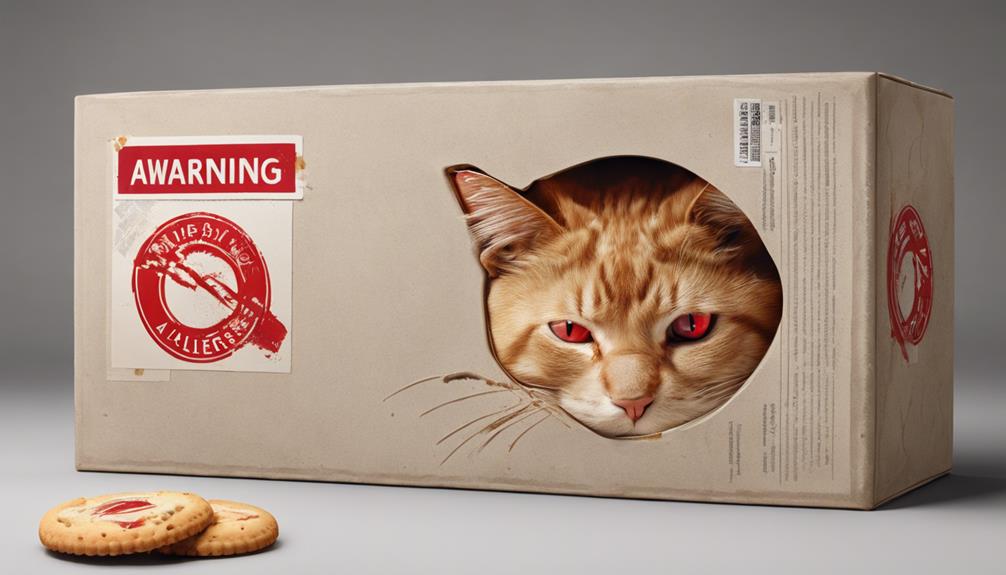
In cases of biscuit allergies in cats, attentiveness is key to identifying potential allergic reactions. Allergies in cats can manifest through various symptoms such as skin rashes, itching, swelling, vomiting, or diarrhea, indicating a negative reaction to specific ingredients in the biscuits.
To address this issue effectively, monitoring your cat's response to biscuits is essential in catching any potential allergic reactions early on. If you suspect that your cat may be having an allergic reaction to biscuits, consulting a vet is vital for proper diagnosis and guidance on how to proceed.
Keeping a detailed record of symptoms and refraining from further biscuit consumption can help in managing allergic reactions in cats, ensuring your feline friend's well-being and comfort. Remember, your cat's health is paramount, and being proactive in addressing any potential allergies is crucial to maintaining their quality of life.
Balancing Biscuits in Cat Diet

Balancing a cat's diet with biscuits requires careful consideration to prevent nutritional imbalances and potential health issues. While biscuits can be a tasty treat for your feline friend, they should only make up a small part of their overall diet. Cats lack the necessary enzymes to efficiently digest the carbohydrates found in biscuits, which can lead to digestive issues if consumed in excess. Overindulging in biscuits can also contribute to weight gain, diabetes, and other health problems in cats, making moderation key.
To safeguard your cat's well-being, opt for cat-specific biscuits that contain safer ingredients and offer better nutritional balance tailored to their needs. By incorporating these treats in moderation and prioritizing a diet that meets your cat's specific nutritional requirements, you can help prevent potential issues related to overconsumption of biscuits. Remember, a balanced diet is vital for your cat's overall health and happiness.
Moderation in Biscuit Treats
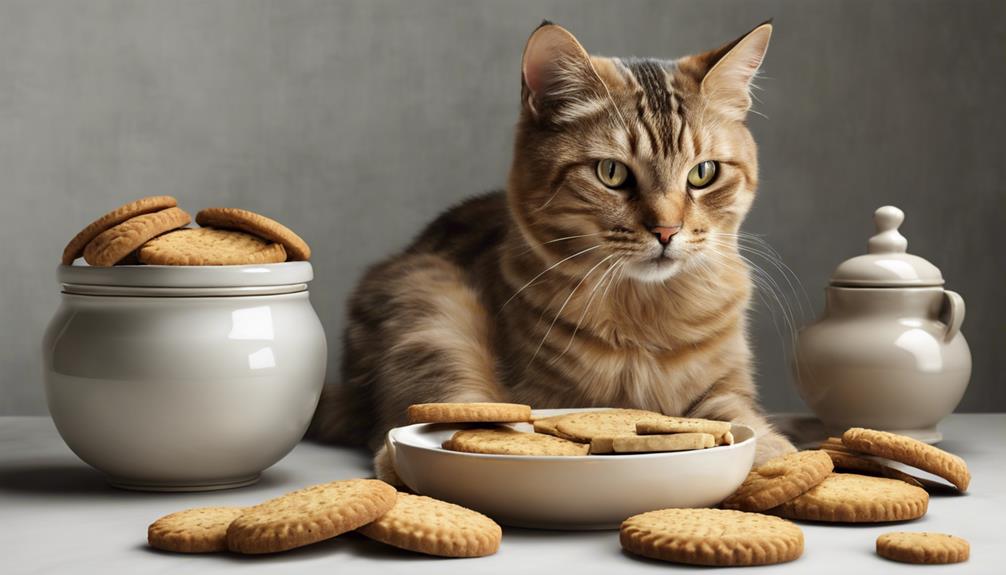
When offering biscuit treats to felines, it's important to prioritize moderation to prevent potential health risks associated with overconsumption. Here are some key points to keep in mind:
- Small Portions: Cats should only have small, occasional amounts of biscuits to prevent weight gain and digestive issues.
- Nutritional Deficiency: Biscuits shouldn't replace balanced cat food as they lack essential nutrients required for feline health.
- Health Risks: Excessive biscuit consumption can lead to obesity, diabetes, and other health issues in cats.
- Healthier Alternatives: Opting for healthier snack options tailored for cats is recommended over relying on biscuits for treats.
It's essential to understand that while biscuits can be a tasty treat for your feline friend, moderation is key to ensuring their overall well-being. By incorporating a variety of snacks and maintaining a balanced diet, you can help prevent potential health complications and keep your cat happy and healthy for years to come.
Impact of Carbohydrates on Cats
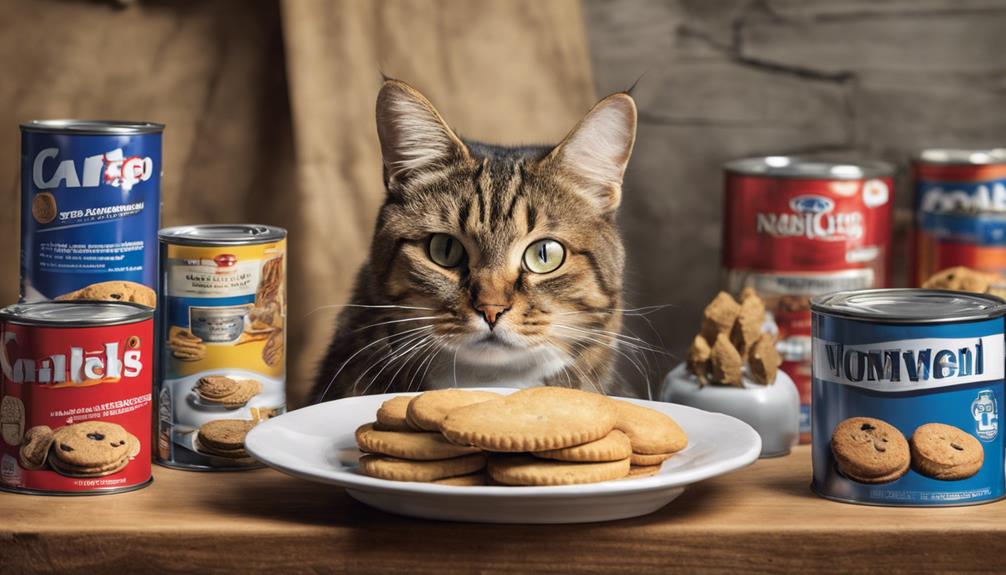
Shifting from the discussion of moderation in biscuit treats for cats, the impact of carbohydrates on felines is significant due to their limited ability to digest and utilize this nutrient efficiently. Cats, being obligate carnivores, have a neat way of processing food, mainly proteins and fats.
When we give them high-carbohydrate types of food like biscuits, it can affect their health more than we realize. Excess carbohydrates can lead to weight gain, obesity, and even more serious conditions like insulin resistance and diabetes in cats. Their bodies aren't built to handle such high levels of carbs, making it essential to be mindful of the carbohydrate content in the food we choose for them.
Limiting the intake of carbohydrates from treats like biscuits is important for maintaining their best health. By focusing on a diet that aligns with their natural needs, we can help our feline friends stay healthy and happy for years to come.
Sweet Biscuits and Cat Health
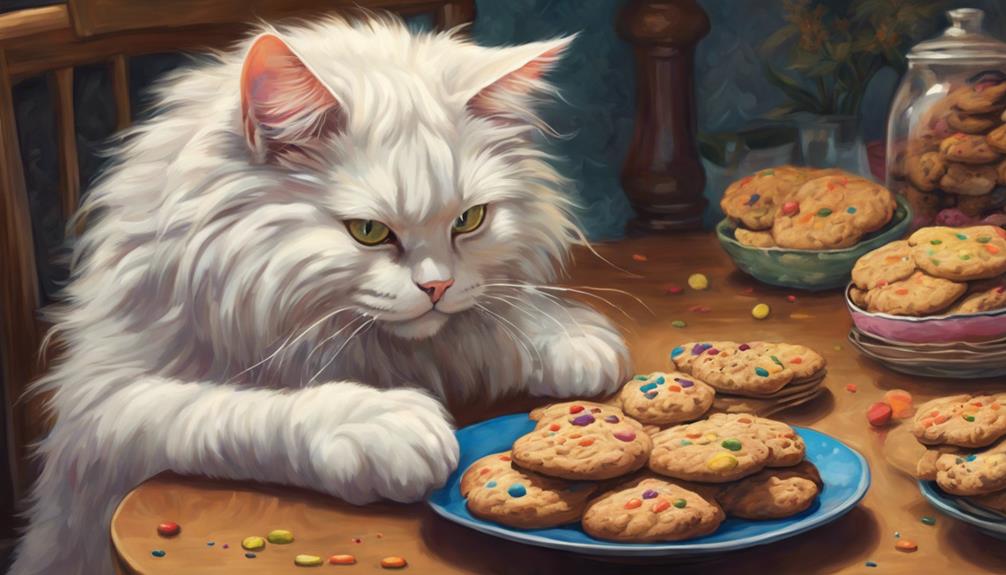
Guaranteeing the high sugar content in sweet biscuits, it's crucial to comprehend how they can impact the health of cats.
- Sweet biscuits contain elevated sugar content that can result in obesity and dental issues in cats.
- Excessive sugar consumption from sweet biscuits can contribute to diabetes in cats.
- Cats lack taste receptors for sweetness, making sugary biscuits unnecessary and potentially harmful to their health.
- Sweet biscuits may cause gastrointestinal problems like diarrhea and vomiting in cats due to their sensitive digestive systems.
When it comes to our feline companions, their nutritional needs are unique. Elevated sugar content in sweet biscuits can have adverse effects on cat health, leading to obesity and diabetes. Cats may not even enjoy the sweetness in biscuits, making them an unnecessary treat that could potentially harm their well-being.
Opting for cat-specific treats ensures a balanced diet and avoids the risks associated with sugary snacks. Prioritizing our cats' health and providing them with treats that aren't only tasty but also beneficial for their overall well-being is crucial.
Savory Biscuits and Cat Wellness
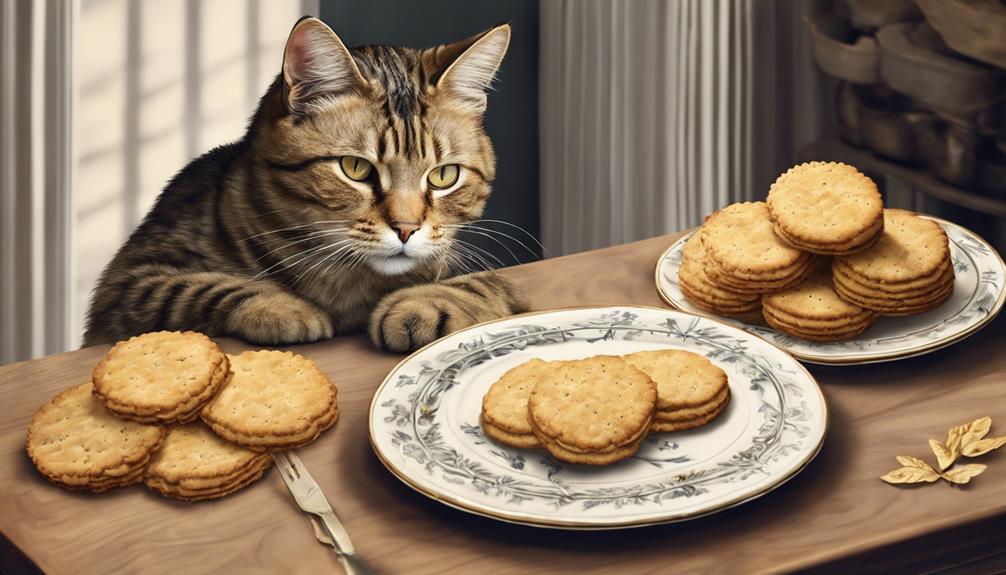
When it comes to savory biscuits and cat wellness, we need to be mindful of what ingredients are safe for our feline friends.
Some components like onion, garlic, and spices can be harmful and should be avoided.
Moderation is key in ensuring that our cats stay healthy and happy.
Nutritional Benefits for Cats
Savory biscuits designed specifically for cats can provide valuable nutritional benefits, enhancing their overall wellness through a crunchy and flavorful treat option. These biscuits can be a great addition to a Cat Kit, offering a source of protein and energy in a different form.
Fortified with essential vitamins and minerals, they support your feline's health. Ingredients like chicken, fish, or vegetables in these biscuits add variety to their diet. When complementing a diet of high-quality cat food, these treats can be a rewarding and nutritious addition.
Ingredients to Avoid
To guarantee the safety and well-being of our feline friends, it's crucial to be mindful of specific ingredients that can be harmful to cats when included in savory biscuits. Ingredients like onions, garlic, and spices are a big no for our neat companions.
Xylitol, a common sweetener in human biscuits, can have serious consequences for our cats. Raisins, often found in savory biscuits, are another danger as they can lead to kidney failure.
Cats mightn't make the best use of biscuits with cheese or certain herbs, affecting their diet and overall wellness. Choosing cat-specific biscuits that don't contain these harmful ingredients is the best way to ensure our furry friends stay healthy and happy.
Moderation Is Key
In moderation, we can offer savory biscuits to our cats as an occasional treat to maintain their wellness. It's crucial to keep an eye on the amount given to prevent any potential health issues. Remember, small amounts are key to enjoying these treats without overloading your feline friend's system.
When selecting biscuits, always check the ingredients list to avoid harmful additions like onions, garlic, spices, or xylitol that could be dangerous for your cat. Opting for cat-specific treats is a safer choice, ensuring a more balanced snack option that aligns with your cat's nutritional needs.
Healthy Snack Alternatives for Cats
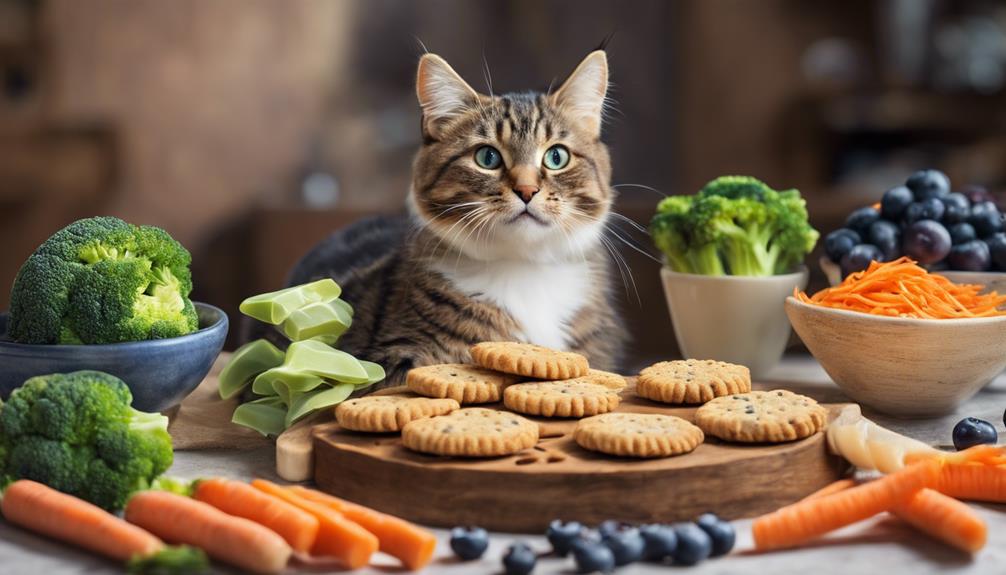
When seeking out healthy snack options for cats, consider incorporating freeze-dried meat treats that are high in protein and low in carbohydrates. These treats come in small pieces that are perfect for feline snacking.
Additionally, small amounts of plain cooked fish or chicken can also serve as nutritious snack alternatives. Catnip is another safe and enjoyable option that not only entertains your cat but also promotes mental stimulation and relaxation.
Cooked eggs, when given in moderation, can be a tasty and protein-rich snack that cats love. Opting for cat-specific snacks over dry cat biscuits ensures that your furry friend's nutritional needs are met, contributing to a balanced diet.
Symptoms of Biscuit Allergies

Symptoms indicating biscuit allergies in cats may include itching, rashes, swelling, vomiting, or diarrhea. These signs can vary in importance and may appear shortly after consuming biscuits. If you notice any of the following symptoms in your feline friend, they could be experiencing a reaction to biscuits:
- Itching: Excessive scratching or licking of the skin.
- Swelling: Visible swelling, particularly around the face, neck, or paws.
- Vomiting: Persistent or recurrent episodes of throwing up.
- Diarrhea: Loose or watery stools that occur frequently.
Being essential for promptly addressing any potential biscuit allergies in your cat. If you suspect your cat is showing signs of a biscuit allergy, it's advisable to consult your veterinarian for a thorough evaluation. Remember, your cat's well-being is a top priority, and understanding these symptoms can help in ensuring their health and happiness.
Ideal Feline Biscuit Consumption
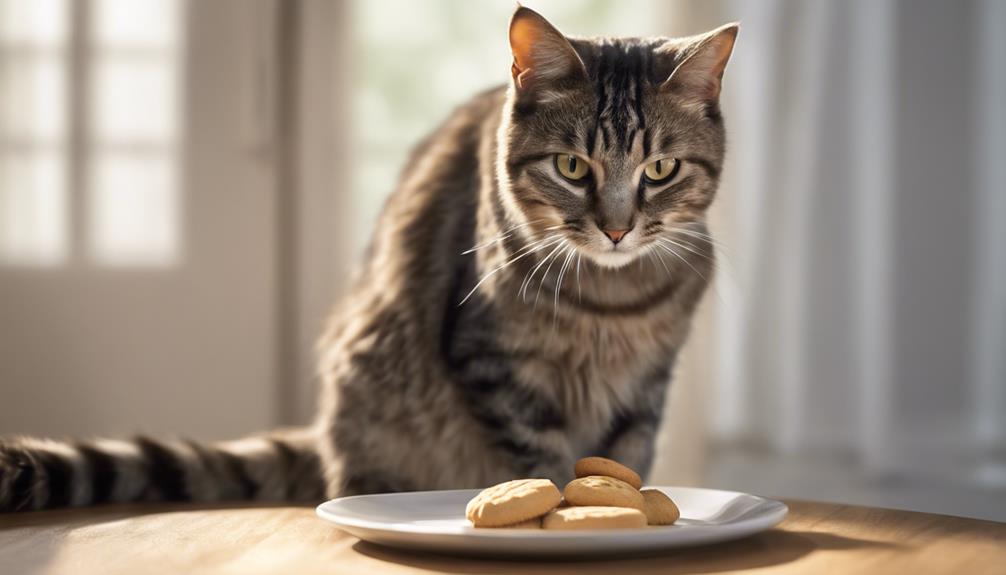
For feline companions, enjoying plain, unsalted biscuits in moderation can be a vital and delightful indulgence. However, it's important to be mindful of the potential risks associated with excessive biscuit consumption. Cats are prone to weight gain, diabetes, and other health issues if they indulge in biscuits too frequently. To safeguard the safety and well-being of our furry friends, opting for cat-specific biscuits can be a prudent choice.
These specialized treats are formulated to meet the nutritional needs of cats while minimizing the risks of adverse health effects. While biscuits can be given as an occasional treat, prioritizing cat-friendly snacks like wet food for their overall health is crucial. By striking a balance and being conscious of how many biscuits we offer our feline companions, we can help them enjoy a tasty snack without compromising their well-being.
Consulting a Vet About Biscuits
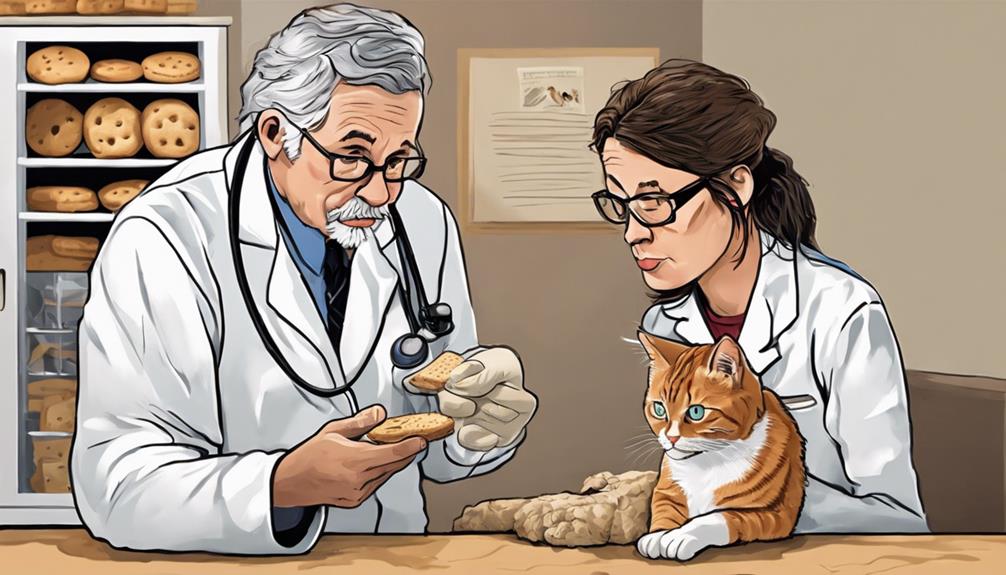
Considering a cat's unique dietary requirements, consulting a vet about suitable biscuit options is essential for maintaining their health and well-being. Vets can provide personalized advice on safe biscuit options tailored to the individual dietary needs of each cat. By seeking veterinary guidance, cat owners can prevent potential digestive issues or allergic reactions that may arise from inappropriate biscuit choices. Additionally, vets can recommend suitable portion sizes and frequency for offering biscuits to cats, ensuring they receive the treats in a healthy and controlled manner.
- Consulting a vet: Essential for personalized advice.
- Safe biscuit options: Tailored to individual dietary needs.
- Prevent digestive issues: By making informed choices.
- Alternative treat options: Recommended if biscuits aren't suitable.
Cat Biscuit FAQs
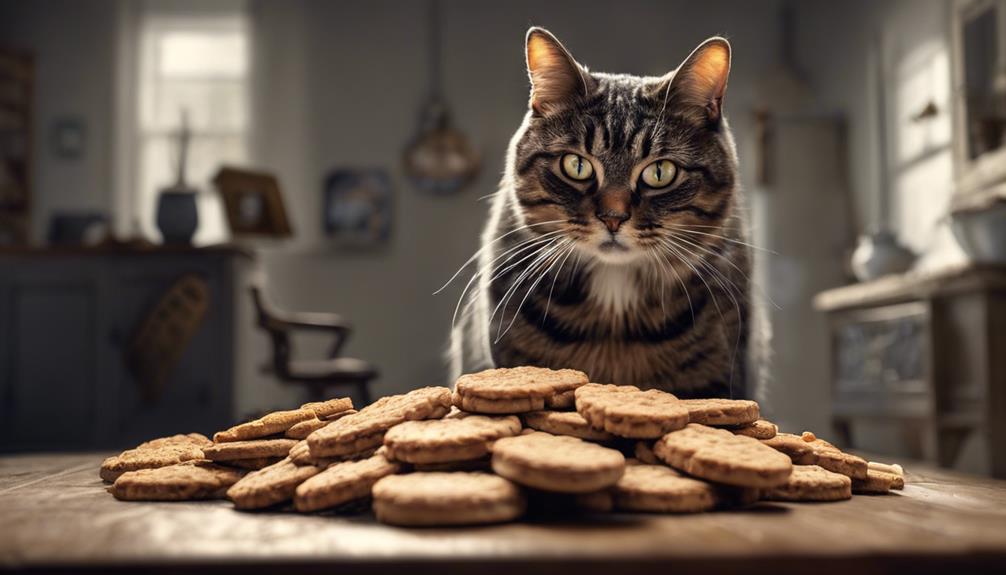
Discussing common questions about cat biscuits can help owners make informed decisions about treating their feline companions. While cats can enjoy plain, unsalted biscuits in moderation, flavored or sweetened varieties should be avoided to prevent digestive issues. The high carbohydrate content in biscuits can lead to weight gain and even diabetes in cats, so it's vital to offer them in limited amounts. If your cat shows signs of an allergic reaction after consuming biscuits, such as vomiting or skin problems, consult a vet immediately, monitor symptoms closely, and discontinue feeding them biscuits.
For healthier snack options, consider offering your cat freeze-dried meat or fruits as alternatives to traditional biscuits. These choices aren't only tasty but also provide more nutritional benefits without the risk of excessive carbs. Remember, moderation is key when it comes to treating your cat with biscuits or any other snacks. By being mindful of their diet and offering treats in moderation, you can help guarantee your feline friend stays healthy and happy.
Frequently Asked Questions
Is It OK for My Cat to Just Eat Biscuits?
Eating just biscuits is not ideal for cats. While they can have them occasionally, focusing on a balanced diet with cat-specific treats is best. Prioritize wet food for meals and offer biscuits sparingly for a healthy feline friend.
How Much Biscuits Should I Feed My Cat?
We should offer only small amounts of biscuits to cats. Overfeeding can lead to weight gain. A single biscuit can be a big portion of their daily calories. Opt for occasional treats and explore healthier snack options.
Should I Leave Biscuits Out for My Cat All Day?
We shouldn't leave biscuits out for our cat all day. It can lead to overeating and health issues. Offering controlled portions and monitoring intake is essential. Let's prioritize our feline friend's well-being by following feeding guidelines.
Is It Safe for Cats to Eat Bread?
Eating bread can be safe for cats in small amounts. It's not a necessary part of their diet, but whole grain options with few additives are better. Watch for any tummy troubles after your cat indulges.
Conclusion
To sum up, while cats can safely enjoy biscuits in moderation, it's essential to be mindful of ingredients, portion sizes, and any potential allergies. Consulting with a vet can provide valuable guidance on incorporating biscuits into your feline friend's diet.
Remember, just like us, cats have unique dietary needs and preferences. By being informed and attentive, you can guarantee your cat's health and well-being while treating them to the occasional biscuit.






